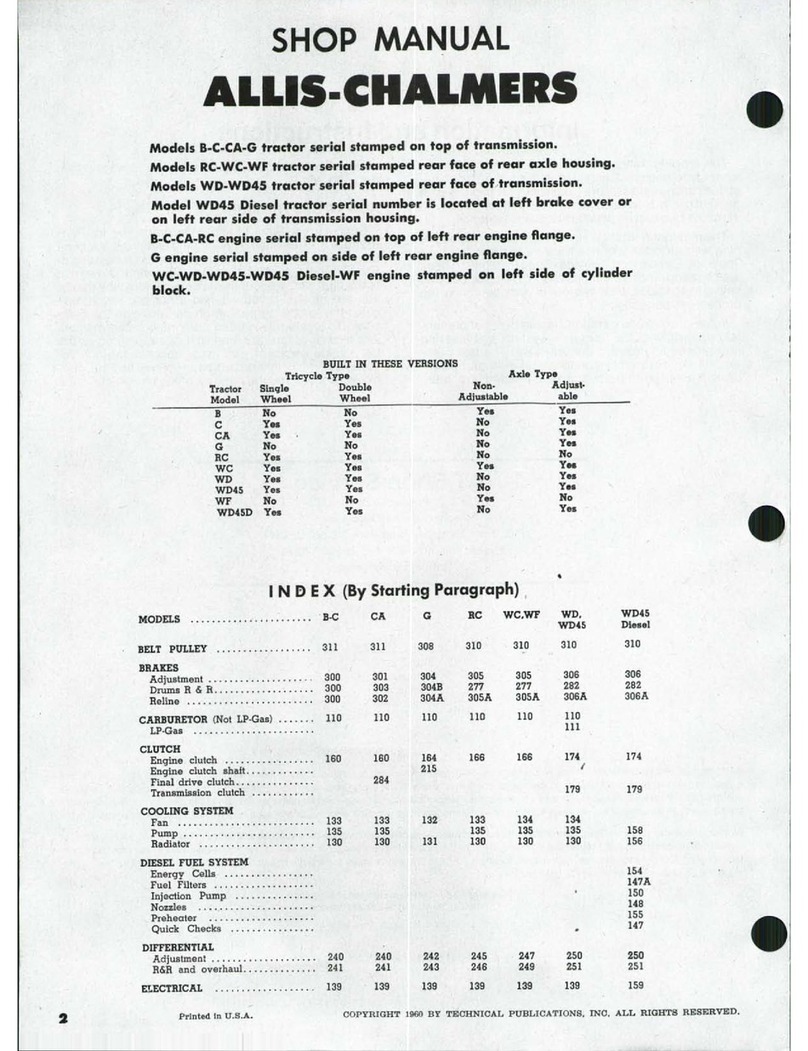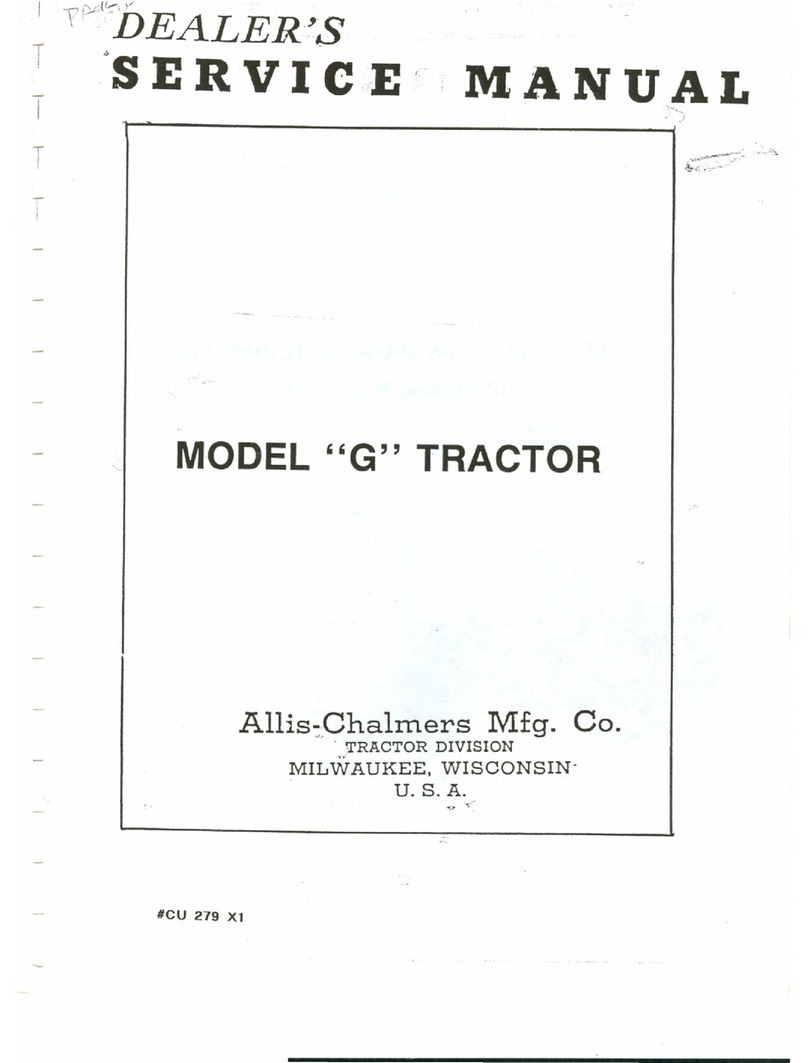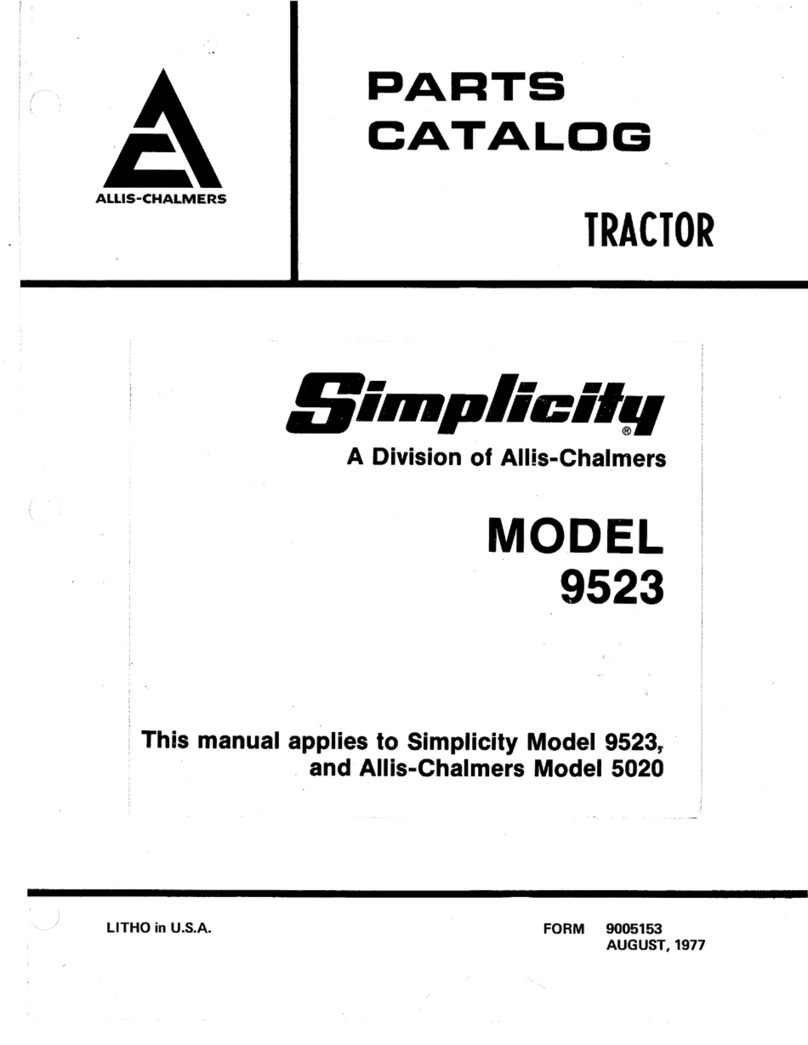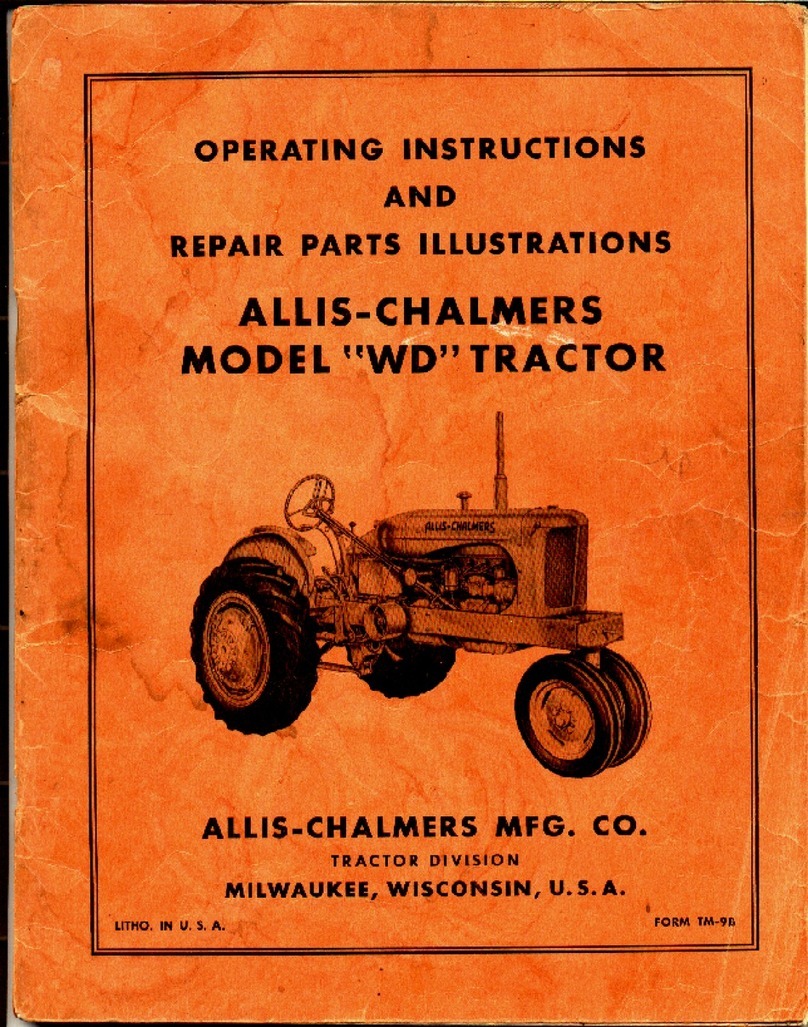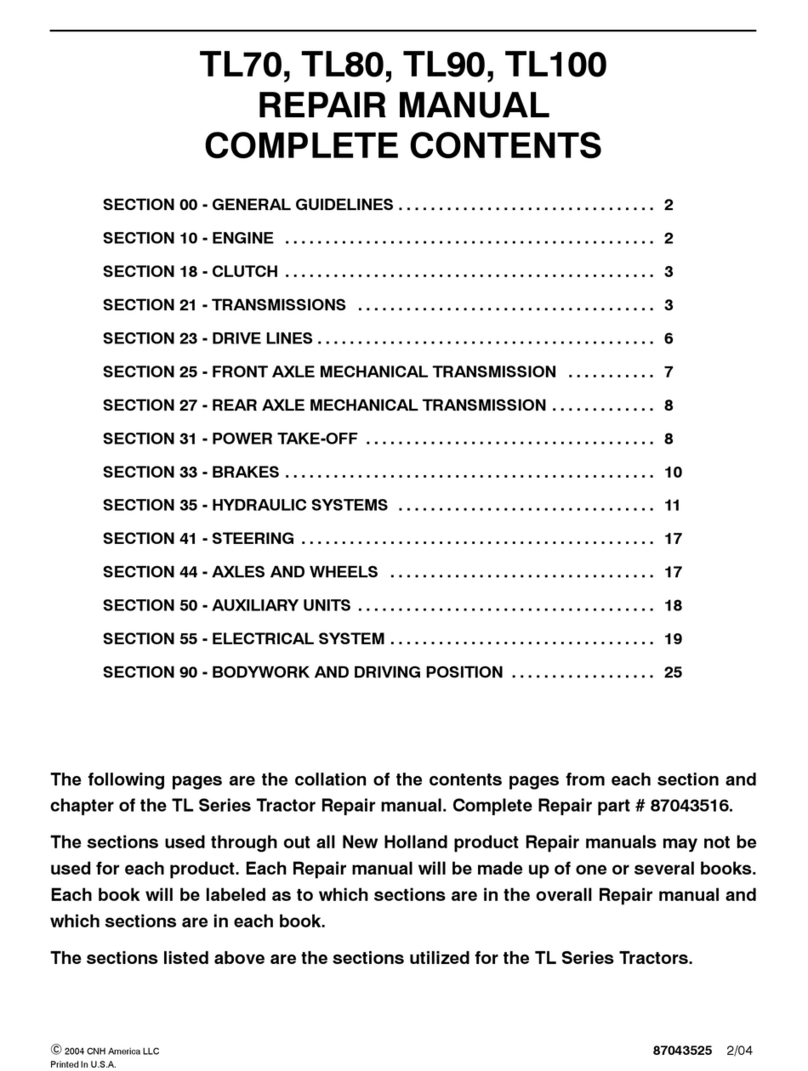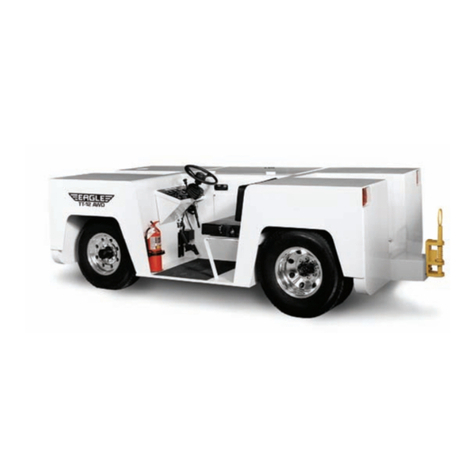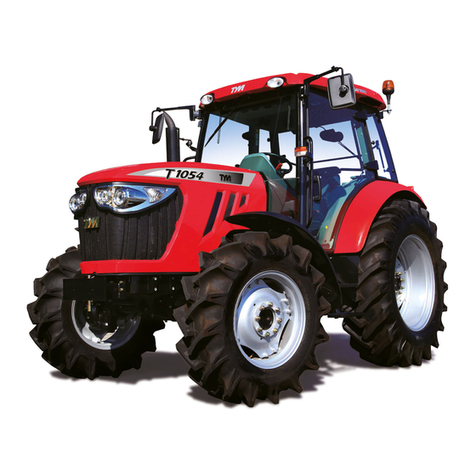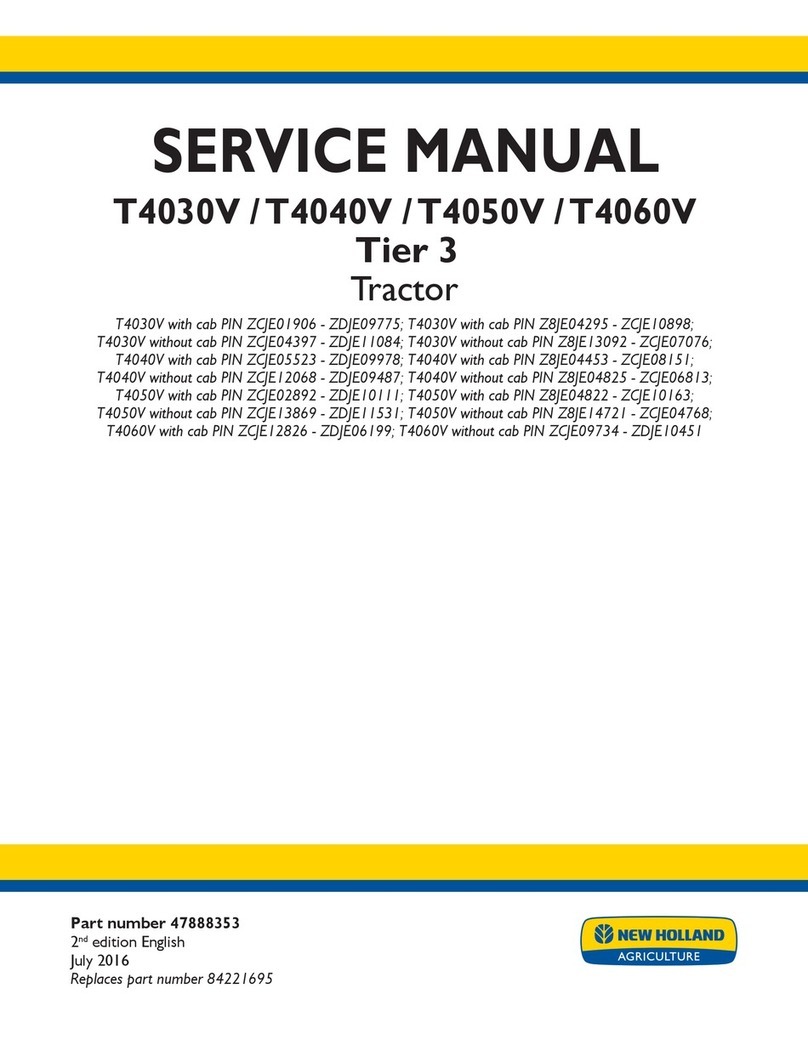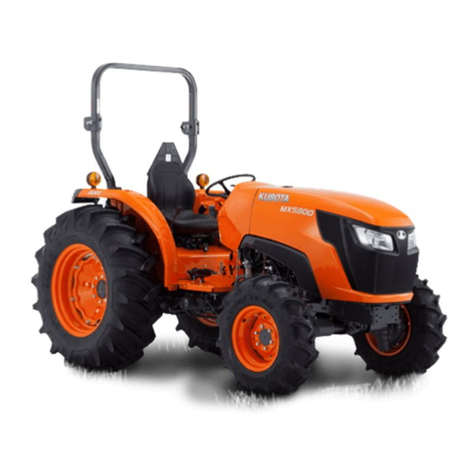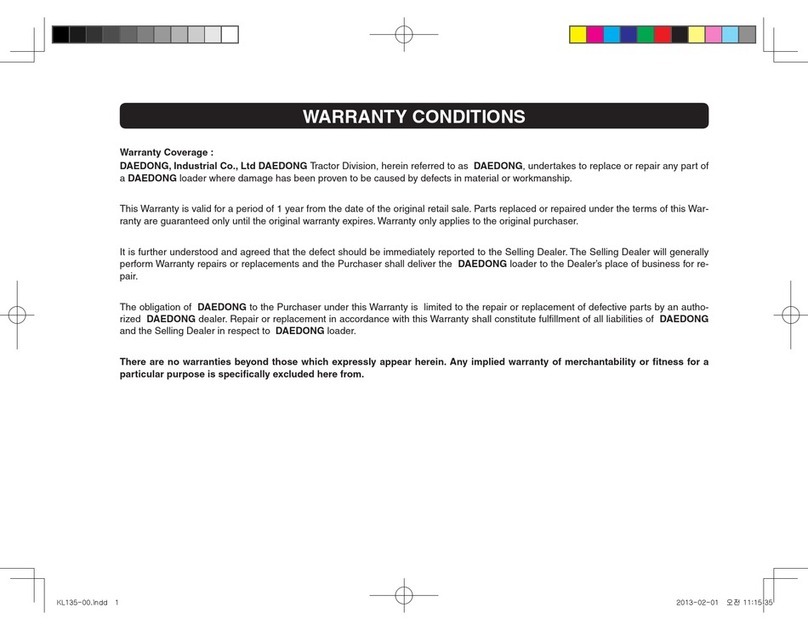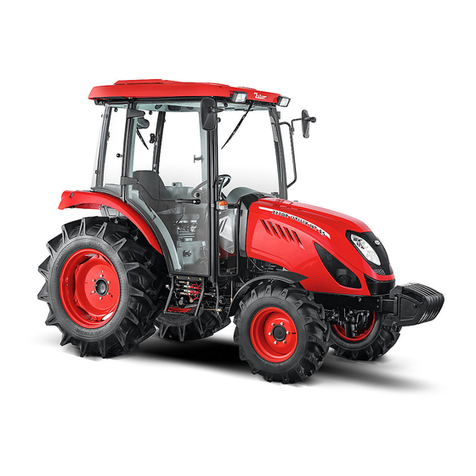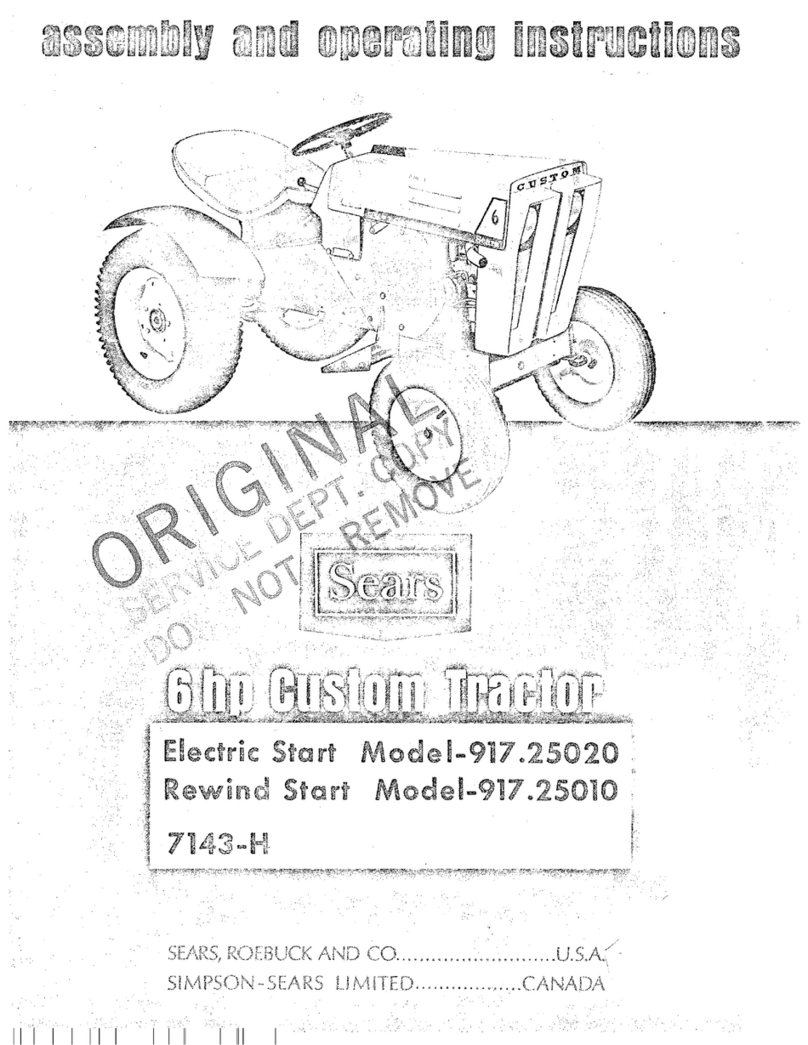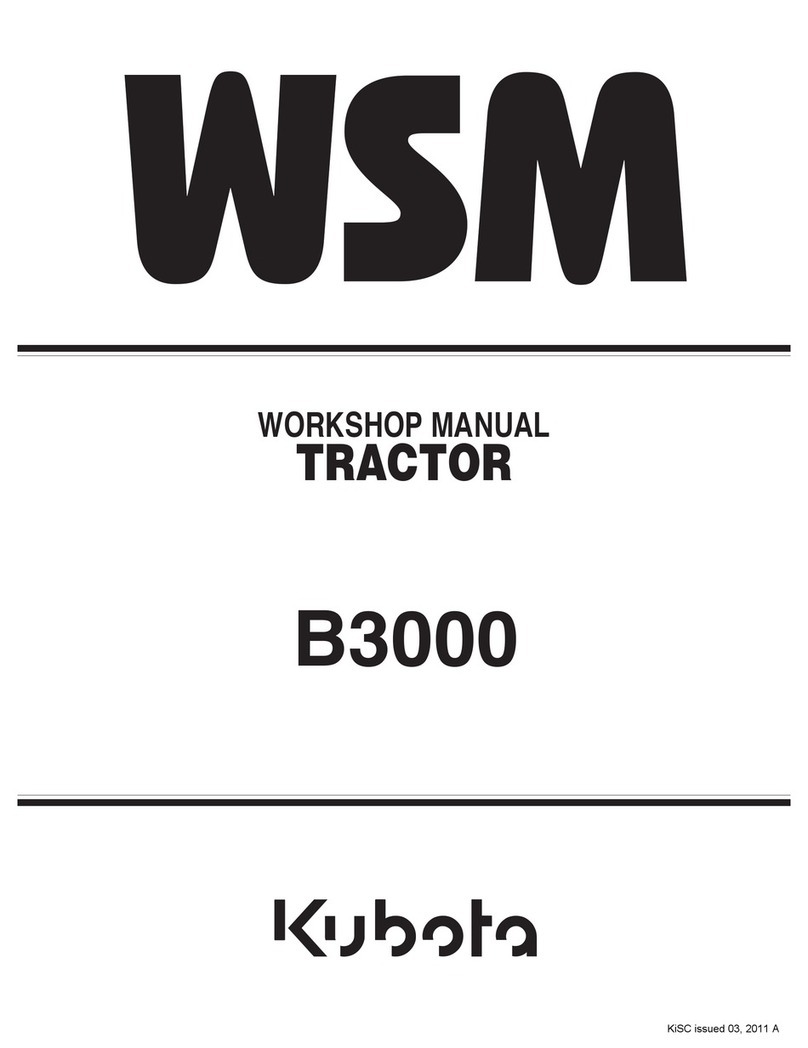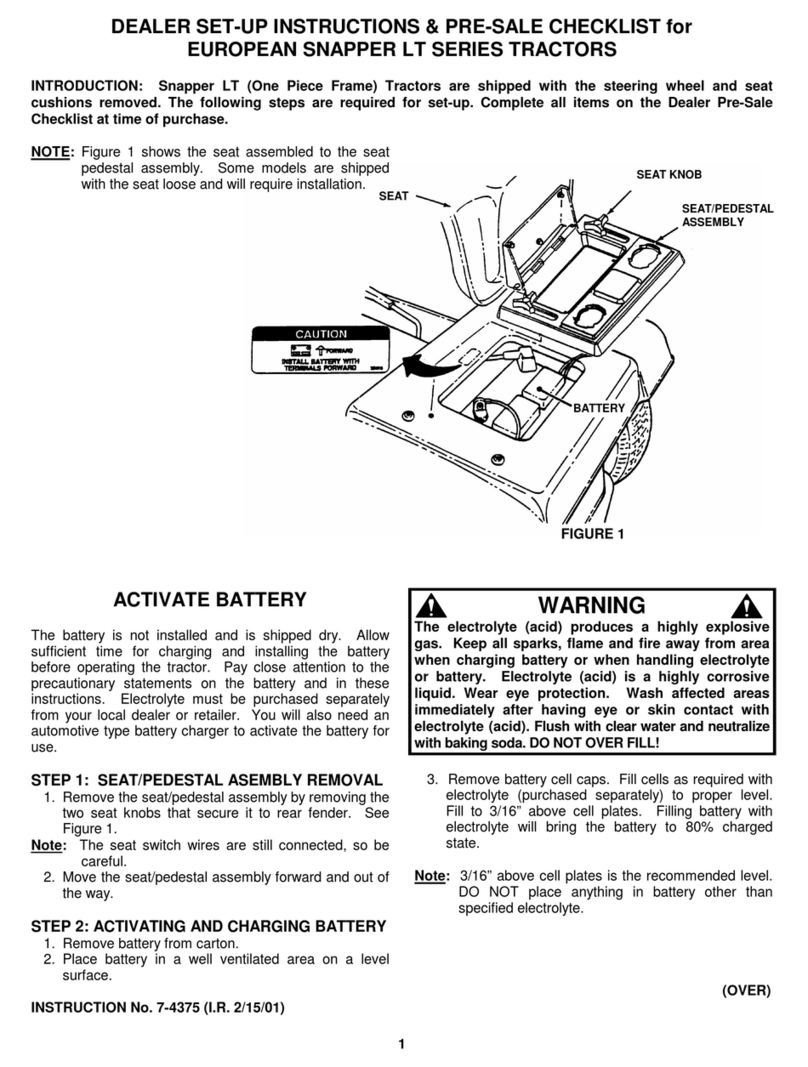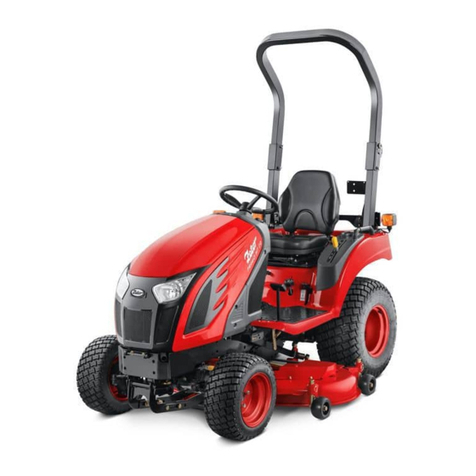Allis-Chalmers HD-9 User manual

SERVICE
MANU
L
FOR
DEL
HD9
TRACT
R
1955
PROPERTY
OF
LITHO. !N U.S.A.
3

FOREWORD
"
TMis
manual
is
prepared
to provide the customer
and
the maintenance
personnel with complete information
and
instructions on
the
mainte-
nance of the Model "HD-9B" Tractor (standard model). Extreme care
has
been
exercised
in
the
designing, selection of materials,
and
the
building of the tractor. By
proper
maintenance
and
skillful operation
of the tractor, the utmost satisfaction
in
performance
and
service will
be
obtained.
In
order
to
become
familiar with the various parts of
the
tractor,
it
is
urged
that
the mechanic study
the
instructions
in
this manual
and
use
it
as
a reference
when
performing repair
or
maintenance operations.
All information
and
photographs shown throughout this manual are of
the
"Standard"
Model "HD-9B" Tractor, unless otherwise stated.
Sections I through
XIX
of this manual contain a
detailed
description
of the various assemblies of the tractor
and
instructions for
the
proper
adjustment
and
repair or rebuilding of these assemblies.
Section
XX
describes the Special Equipment available for
the
tractor
and
outlines the service of these parts.
General
Maintenance Instructions are given
in
Section XXI,
and
Fits
and
Tolerances
in
Section XXI/.
Trouble Shooting Information given
in
Section
XXIII
will
aid
in
deter-
mining
the
cause of
operating
irregularities
and
tells
what
may
be
done
to correct them.
General
information on
the
availability of
Special Tools is given
in
Se.ction XXIV.
To
assure
the
best
results
and
to maintain the original quality built
into
the
tractor,
it
is
important that
Genuine"
Allis-Chalmers" Parts
be
used
when
new
parts are required.
IMPORTANT:
ALWAYS
FURNISH
THE
DEALER
WITH BOTH
THE
TRACTOR
AND
ENGINE
SERIAL
NUMBERS WHEN ORDERING, pARTS.
Many owners of
"Allis-Cha/~Jii.s"
equipment
employ
the
Dealer's
Service Department for all work other than routine care
and
adjust-
ments.
This
practice
is
encouraged
as
our dealers are
kept
well informed
by
the
factory regarding
advanced
methods of servicing "Allis-
Chalmers" products
and
are
equipped
to render satisfactory service.
4

SUBJECT
INDEX
SUBJECT
PAGE SECTIOlli
Description
and
Specifications 1
Engine Fuel System
15
Engine Air Intake System
43
Engine Cooling System
68
Engine lubricating System
81
Engine Controls
and
Governor
94
Electrical System 104
Instruments
112
Engine 115
Engine Clutch
and
Clutch Brake 174
Transmission
and
Bevel
Gear
187
Steering Clutches
and
Controls 208
Steering Brakes 219
Final Drives 224
Truck Frames
241
Draw Bar 259
Tracks
261
Main Frame
and
Equalizer Spring 266
Fender
and
Seat
Group 270
Special Equipment 272
General
Maintenance Instructions 282
Fits
and
Tolerances 287
Trouble Shooting 295
Special Tools 313
.(~
5

SECTION
I-DESCRIPTION
AND SPECIFICATIONS
Topic Title Topic No.
General Description
...............
1
General Specifications
.............
2
Specifications of lubricants
..
. . . . . . . . 3
Specifications of
Fuel
..............
4
Fuel
Storage
.....................
5
Tractor
and
Engine Serial
Numbers.
. . 6
1.
GENERAL DESCRIPTION
The description given herein
and
the information
contained
in
this manual pertains to
~he
Model
"HD-98" Tractor (Standard Model), unless other-
wise stated.
The Model "HD-9B" Tractor
is
on 18,800 pound
track-type tractor powered with a 4-cylinder,
2-
cycle
"DIESEL"
Engine. Power from the engine
is
transmitted through a single plate, over-center type
engine clutch to the transmission through a drive
shaft universal joint assembly.
From
the trans-
mission, the power
is
transmitted to the bevel
gear,
and
from the bevel
gear
through two multiple disc
steering clutches (one on
each
side
of
the bevel
gear
shaft) to the final drives
and
the track drive
sprockets.
The
transmission provides 6 forward speeds rang-
ing from 1.4 M.P.H.
in
low
gear
to
5.7
M.P.H.
6
in
high
gear
and
3 reverse speeds ranging from
1.6
M.P.H.
in
low
reverse to 4.4
M.P.H.
in
high
reverse, under
full
governed engine
speed
of
1600
R.P.M.
Mechanical "Booster-Type" steering clutch
Con-
trols, mechanical self energizing brakes, adjustable
and
wide operator's seat,
and
unobstructed view
of the front of both tracks assure easy, positive
control of the
trador
at
all times.
The tractor
is
equipped with electric starting
and
lighting equipment, muffler,
full
width crankcase
guard,
front pull hook, bumper, hinged type
radi-
ator
grille, suction type fan,
and
16-inch integral
grouser shoes.
The
truck wheels, track idlers,
and
support rollers have positive type seals
and
are
protected by guards.

BACK
TRUCK
WHEEL
OUTER
TRACK
SUPPORT
EXHAUST
STACK
AIR
PRE-CLEANER
~
~
'RADIATOR
CAP
/
HEADLIGHTS
RAI)IArOR GRillE
HOOK
GUARD
L
______________
Fig.
I-Model
HD-9B Tracfor
______________
.....J
7

8

2.
GENERAl. SPECIFICATIONS
(STANDARD TRACTOR)
GENERAL SPECIFICATIONS:
Overall
length
,
.•
'
.•.
'
...
,
........
".,
..
,
.......•.
',."
..
"
....
,
...
,.,
........
,."
..
"
....
12
ft.
6 in.
Overall Height (without ,tacks)
.,
.•.........
"
....
,
•....
".,'
.....
,
•..
,.,
....
"
...........
," 6
ft.
11>
in.
Overall Width (standard
,hoe,)
...........................
"
.................
"
.........
7 ft.
11-1/16
in.
Turning Radius
..
,
....
,
....
,
............•.......
,
........
,
......•.....
,
....
,
.........
,
.....
8 ft. 7% in.
Ground Clearance
..•...•..........................
,.,
...
,
............
,
..
,
.................
13-5(16
in.
Drowbor Height (center line of jaw)
.,.'
..
"
.....
,",.,
....
,
.....
,'
...
,.'
........
'
....
,.,.',.
16-17/32
in.
Lateral Drawbar Movement
.•...
,
.•...............
,
.•.
"
.....•..
,
....••..•.............•...•.•..
26%
in.
Shipping
Weight
(approximate)
..•..
,
......
,
....
"
..
,.'.',
......
,.,."
..........
',
..
,
...
"
...
1
a,BOO
Ib,.
length
of Track on Ground "
•....•..
,"',
.....
,
...•
"
..
,
..
"
........
,.,.,
•....
,
.....
",
...
7 ft.
1%
in.
Width of
Standard
Track Shoes
.••....
""'
............
,
..
,
..
,.,
•.....
"
..
',
...
,
......
,'
........
,'
16 in,
Maximum Width Track Shoes Available
.. .,
, , , ,
........
.,
, , . , ,
....
, ,
.....
,.,
. , . ,
...........
,
.......
22
in.
Ground Contact Area
(standard
,hoe,)
...
"
..
".,
...
"
...
"
..
"
..............
"
........
.,
....
2744 sq. in.
Number of Track Shoes
per
Track
...
" ,
""
..
, ,
..
, , . , , , "
.,
...
, '
....
,
.......
.,
,
...
,
.........
, ,
..
,
..
, .3B
Ground Pressure
per
Sq.
In.
(standard
shoes)
....•
"',.,
..
"
•..
,.,
...
,
•....•....
,.,.,
....
,,
....•
' ,6.B5 Ibs,
Tread width
(center.to~center
of
tracks)
......
,
...•........
,
....
,',
.........
,
....•..............
,"
,74
in.
TRACTOR
SPEEDS
(at
Rated
Engine
Speed):
GEAR RANGE
SPEED
lst
Gear
..
,
....
,
...
,
.......
,.,"",
.......
,',.,
...
,
....
,
..............
,
..
,
..
"
•...
,
....
,
..
1.4
M.P,H.
2nd
Gear.,.,
, . , . ,
..
, ,
......•..
, ' . , , ,
.........
'
.....
,
....
,
..
, ,
..
,
.........
, .
,.
, . ,
.•.
, . ,
....
2.1
M,P,H.
3rd
Gear
•...•..
"."
...
,.,
......
,.,
.....
,
.....
,
...
,
......
,.""
...........
,
...
",
.........
2,9
M.P,H,
4th
Gear
••....
,
...
,.,"',
......
,.,."."
....
,.,.,"',
.........
,."
.........••.
,."
..
"
..•.
3.8
M.P.H.
5th
Gear
.............
,',.,
....
,."
...
,
..
,
..........
"
....
,.,
...
,.,
...
,",
...
,',.,",."
••.
4.4
M.P.H.
6th
Gear"
..........
,',."
.......
,.".,',
..
,
.......
,",
...........
,
...
,
..
,
....
,
......
,',
..
5.7
M.P.H.
1st
Reverse,.,.,
....
,
..
,.",
...
,
.......
"
...
""
......
,.,."
.....
,.,."
............
"""
..
1.6 M.P.H.
2nd Reverse
............
""
................
,
.................
",
.........
"
...........
,.,
..
3.5
M.P.H.
3rd
Reverse.,
...........
,
....
",
........
,
....
".,
.........
,
...
",.,
.......
"
.....
,
.....
"
..
4.4
M.P,H.
ENGINE:
Make
•.
,
.......•
,.,
..•.......•.....•..•.•••.•
,
.......•..
,
.•.........••...
',
•••
IIGeneral MotorsN Diesel
;:Y~;b~;~i
Cyii~d~~;
'.''-.'.'.'.'.'.'.'.'.':.'.'
.
.'.'.'.''.'''-'
'-:::.'
. .'.'
::.'.'.-.'.-.-::::.'.':.-:::.'.-.':
..
"
::.:.:::.'
.'.".r~aCy~l:
Bore
...•
,
...•.•.........
,
......••••.
,',.,.,
....
,
.••.•..•......•.
,.,
••...•...••••
,
•....•......
41;,1
in.
Stroke
.•••..•..
,
........••....
"."
..
,
...•••..
,
...
,',
.•.
"
..
""'
••...•......
"
..
,.,
••
,"'
.....
,,'
5 in.
Piston Displacement
...
,.,
.......
"
...
"
................
,
...
,
.•
"
...................
,',
.....
,
2B4
cu. in.
Engine
Speed
(governed
at
full lood)
.......
,'
...•
,',
.....
,
.......•
,
..
,',
....•
,"
..
,.",
....
,1600
R,P,M.
lubrication
.,
.......
,
......
".,
............
,.,
...
,.,.,
•....
,',
.......
,,'.,
...
,.,
......
,
...
Forced Feed
Foel
Used
..
,
.........
"
..
,
...
,
........
,.,
........
.",
.....
'
....
., ..
,.,
...
,.,
No. 1 or No. 2 Die,el
Fuel
Fuel Supptied by
..
"
...............•..•..
"
........
"
......
,.,
....•..•
,.,"'
...
55
cu.
mm.
Unit Injectors
CAPACITIES
(Approximate)
(U.
S.
Standard
Measure):
Cooling System
...
,',',
.....
,.,
...
'.,
..
,
.....
,'.'.,.,',
....
,"."
........
"
......
,',
.....•...
7Y.i
Gal"
Crankcase
and
Filter
.,
....•.........
,
..
,.,',.,
..
',
...........•.
,',
.......
, , , . ,
..
"
..........
,
..
,4
Gals.
Transmission
Case,
....
,
.'
...........
,
.................
,
..
, . , . ,
........
, , , , , ,
..•..
,
......
, , , .
,6JA
Gals.
Finol Drives (each)
..
,
....
,.,.,"
......
,.,',
..
"
....
,',
..
,
...
,
...........
,,',.,
..
,',
..
,'
..
,
,.3v..
Gals.
fuel Tank
.',
..
,.,
..
,
......
,.,
.....
,.,"'"
......•.....
'."
.....
,
"',
...
,
.....
,
..
".,',.,
...
55
Gols.
Track Release Housing (each)
•..
,.,.,.,
..........
,',
••.
,
.....•.
,.,.,
.•.......
"',
•..
,,.,
...
,
...
,2
Gals.
Air
Cleaner
...
,',
..........
',.,
.....
,.,.,
...
"
..
'"
...
',
....
,
.............
,.,
",
..
,."".,
..
1 Gol.
The Allis-Chalmers Manufacturing
Company
reserves the right to
make
changes
in
the
above specifications
or
to
add
improvements
at
any
time without notice
or
obligation.
9

3.
SPECIFICATIONS
OF
LUBRICANTS
A. Engine
Crankcase
Lubricant
USE
NON-CORROSIVE
"DIESEL"
ENGINE
WBRI-
CATING
OIL
CONTAINING
ADDITIVES
WHICH
WILL
PREVENT
SWDGE
OR
GUM
DEPOSITS_
UNDER
NO
CIRCUMSTANCES
SHOULD
A
COR-
ROSIVE
"DIESEL"
ENGINE
LUBRICATING
OIL
EVER
BE
USED.
Use
oils
of the following viscosities,
Atmospheric
Temperature
Viscosity
Above 32°
F.
Use
SAE
30
0°
F.
to
320
F.
Use
SAE
20W
0°
F.
and
below
Use
SAE
lOW
Manufacturers of lubricants recognize the impor-
tance of the qualities required for use
in
our equip-
ment
and
they
are
cooperating
fully
to assure the
use of only those oils which
fulfill
these require-
ments. The
oil
distributor
and
oil
manufacturer
are
to be held responsible for the results obtained from
their products.
The outstanding lubricating requirements for effi-
cient operation of the engine are, The maintaining
of piston rings
in
a clean, free condition; absence
of hard carbon
and
"varnish" deposits on or within
engine ports; the prevention of bearing corrosion;
and
the
promotion of general cleanliness within
the engine.
Proper operation
and
maintenance of the engine
are
necessary to obtain the desired results from
the lubricating oil.
B.
Transmission
and
Final Drive
Lubricant
Lubricate these assemblies with
any
good
grade
10
of engine lubricating
oil
purchased from a
reputa-
ble
oil
company.
Use
oils of the following viscosities:
Atmospheric
Temperature
Viscosity
Above 32°
F.
Use
SAE
50
320
F.
and
below
Use
SAE
30
C.
Track
Release
Housing
Lubricant
Lubricate these assemblies
with
SAE
50
engine
lubricating
oil
in
all seasons.
D.
Truck
Wheel,
Track
Idler,
and
Track
Support
Roller Lubricant
Lubricate these assemblies
with
a grease
that
has
been tested
and
found satisfactory for use by
the
Allis-Chalmers Manufacturing Company. A revised
list
of approved greases
is
issued every six months.
Ask
your nearest "Allis-Chalmers" authorized
Dealer for the latest
list.
E.
Pressure
Gun
Lubricant
Use
a ball
and
roller bearing lubricant with a
minimum melting point of 300°
F.
This
lubricant
should have a viscosity range
so
as to assure
easy
handling
in
the pressure gun
at
the prevailing
atmospheric temperature.
This
lubricant must
be
waterproof.
f.
Air
Cleaner
Use
the
same viscosity
oil
in
the air cleaner
as
used
in
the
engine.
CAUTION:
Do
not use on oil that
foams.

4.
SPECIFICATIONS
OF
FUEL
Use
a No. 1
"DIESEL"
Fuel
purchased from a
reputable
oil
company.
In
warm weather
No.2
"DIESEL"
Fuel
may be used.
This
fuel
must
be
within the classification limits as established
by
the
American Society for Testing Material, Tentative
"DIESEL"
Fuel
Oil Specifications
(ASTM
0975).
For
longer engine life
and
performance, fuel re-
quirements
mus~
comply with four basic qualifi-
cations:
I. Physical cleanliness.
2. Absence of chemical contamination.
3. Proper burning characteristics.
4. Cold starting ability.
Physical cleanliness means freedom from water,
dirt,
and
other incombustible ingredients. Since
all present
day
high speed
"DIESEL"
fuels
are
com-
pletely distilled, they leave the refinery
in
clean
condition.
The most objectionable chemical contaminants
are
free sulphur
and
gum, which, even
in
relatively
small quantities
are
largely responsible for harm-
ful
internal engine deposits. The fuel must also be
11
free from alkali
and
mineral acids.
Proper burning characteristics
are
dependent upon
ignition quality
and
volatility.
All
fuels meeting the requirements of the No.
1-0
and
also the lighter types of fuel
in
the No.
2-D
grade
of ASTM-D975
"DIESEL"
Fuel
Oil Specifica-
tions
are
satisfactory.
The
more volatile
grade
(ASTM No.
I-D)
is
recommended for all types of
service where frequent speed
and
load changes
occur, while fuels
in
the heavier
grade
(ASTM
No.
2-D) may be used with sustained high loads.
Prolonged use of fuels combining low ignition
quality (less than
45
Cetane Number) with high
boiling temperature (more than 6750
F.
end
paint)
should be avoided, particularly
in
cold weather.
CAUTION,
The
sulphur content of
"DIESEL"
fuel
should be
as
low
as
possible.
For
warm
weather
conditions, the fuel should contain not more than
V.
of
1% sulphur.
For
cold weather operation, fuel
with not more than
3/10
of 1% sulphur
is
preferable.

5.
FUEL
STORAGE
The importance of proper storage of fuel cannol
be
too strongly stressed. Storage tanks, drums, or
service tanks must
be
free from rust, scale, sedi-
ment, or
any
other foreign molter which
will
contaminate the fuel. Dirty fuel
will
clog the fuel
filters
and
eventuolly
damage
the fuel pump
and
injectors.
A portable storage tank provides the best method
for storing fuel on the job.
In
a storage tank, the
sediment
and
water can easily
be
drained
and
the
fuel can be pumped into the tractor fuel tank with
a
minimum
of handling. Consult your nearest"Allis-
Chalmers" Dealer for details
about
this type
of
storage tank. Since condensation
will
occur
in
the
storage tank,
it
is
very important
that
a sediment
sump be provided
50
that
water
and
se'ltlings
ccm
be drained daily.
Fuel
should be allowed to settle
at
least
48
hours
in
the storage container before
it
is
added
to the
fuel tank of the tractor.
It
is
advisable to use a
pump
and
draw the fuel from the container rather
than to drain
it
from the bollom of the container.
Where conditions
are
such that drums must
be
used
to supply fuel,
it
is
advisable
to
have enough drums
to allow sufficient time for the fuel to sellie. The
fuel should be used only to within about three
(3)
inches from the bottom of the drums.
The
fuel thus
left
in
a number of drums can be collected into
one drum
and
used after the usual time allowed
for settling.
In
this
manner, the sediment
and
for-
eign matter
will
be disposed of
and
no fuel
will
be
wasted. Whenever drums
are
used for fuel
storage,
they should
be
covered
or
placed under shelter
to
avoid contamination of
the
fuel
by
water, which
will
enter through the filler plugs when it rains,
even though the plugs
are
tight.
The fuel tank of the tractor should
be
filled
at
the
end
of
the day's run rather than
at
the start; this
will
reduce the water content,
as
a
full
lank
is
less
subject to condensation. The tractor fuel tank
is
provided with a drain elbow
and
drain cock, for
draining accumulated
waler
and
sediment.
L-
_______________
Fig. 3 Fuel Storage Tonk
--------
______
---J
12

6.
TRACTOR
AND
ENGINE
SERIAL
NUMBER.S
On all parts orders
and
in
all correspondence rela-
tive to the tractor, it
is
necessary that both the
tractor
and
engine serial numbers be given.
This
will
properly identify the particular machine
and
will
assure obtaining the correct replacement parts
for it.
The tractor serial number
is
stamped
in
the
rear
13
face of the steering clutch housing (near the upper
right corner)
and
is
also stamped on a serial
number plate
attached
to the cowl.
The engine serial number
is
stamped on the upper
right side of the cylinder block, below the governor
control housing.

14

SECTION
II-ENGINE
FUEL
SYSTEM
Topic Title
Description
of
System
............
. Topic No.
1
Checking
Fuel
Supply System
......
. 2
Fuel
Tank
and
Drain Elbow
........
. 3
Fuel
Filters . . . . . . . . . . . . . . . . . . . . . .
..
4
Fuel
Pump.
. . . . . . . . . . .
..
. . .
..
.
..
5
Fuel
Injectors
...................
6
Injector Copper
Tubes.
. . . . . . . . . . . . 7
Fuel
Manifolds . . . . . . . . . . . . . . . . . . . 8
1.
DESCRIPTION OF SYSTEM
The
engine fuel system consists of the fuel tank,
first stage fuel filter, fuel pump, second stage fuel
filter, injectors, fuel lines,
and
fuel pressure
gage.
The
fuel
is
drawn from
the
bottom of the fuel tank
and
through the first
stage
fuel filter by the fuel
pump.
The
pump then circulates the fuel under
pressure through
the
second'stage
fuel filter, fuel
inlet monifold
on
the right side of the cylinder
head,
and then through the injectors.
As
the fuel
enters each injector, it passes through a small
porous metal filter
in
the injector body. The amount
of fuel required by the engine
is
injected into the
cylinders by the injectors; surplus fuel, not required
for combustion, leaves eoch injector through an-
other porous metal filter, enters the return fuel
manifold and
is
returned to the fuel tank. A pres-
sure of
20
to 55 pounds
is
maintained within the
fuel system by a restricted fitting located
in
the
rear
of the return fuel manifold.
The
continuous
circulation of fuel helps to cool the injectors
and
eliminates the possibility
of
air pockets
in
the fuel
system.
INJECTOR
FUEl
LINES
RETURN
FUEL
MANIFOLD
FUEl
TANK
DRAIN
COCK
~~,
."
...
"
;:
"
"
"
"
"
"
"
"
.,
RETURN
TO
TANK
~::::==~=:9
FUEl
TANK
SHUT.OFF
VALVE
INJECTORS
O--o-O~o
2nd
STAGE
FUEL
FILTER
\ ( \
INLET
FUEL
MANIFOLD
u
ht
STAGE
FUEL
FILTER
'---
____________
fig.
I-Schematic
ruel
Flow
Diagram
____________
----'
15

2.
CHECKING
FUEL
SUPPI.Y SYSTEM
A.
General
Under normal conditions, with the
engine
running
at
full throttle,
20
to
55
pounds pressure will
be
indicated on
the
fuel pressure
gage.
Fuel pressure
below
normal, uneven running of
the
engine,
ex-
cessive vibration, stalling when idling,
and
a loss
of power
are
indications of insufficient fuel supply
to
the
injectors.
To
determine
the
cause
for
the
above
conditions, check for
the
following:
1. Air being
drawn
into fuel system on
the
suc-
tion side of
the
fuel pump.
2.
Clogged
fuel filter elements
and
fuel lines.
3.
Clogged
injector fuel filters.
4. Inoperative fuel pump.
B.
Check
for
Full Flow
of
Fuel
Through
System
To check
the
flow of fuel through
the
system, dis-
connect
the
fuel return line
at
the
fuel
tank.
With
the
engine
operating
at
high idle,
the
system
will
be
functioning
properly
when a full stream of fuel
with considerable pressure can
be
observed re-
turning to
the
fuel
tank
through the return fuel
line.
If
only a small stream
is
observed returning
to the tank, all causes listed
above
must
be
checked
and
eliminated
in
turn.
C.
Check
for
Admission
of
Air
into
System,
Clogged
Fuel
Filter
Elements,
and
Clogged
Fuel Lines
To check for
air
being
admitted
into
the
system,
follow
the
same
procedure
as
used
in
checking
for
flow of fuel.
If
air
is
entering into fuel system,
foam
or bubbles will
be
observed
in
the fuel
that
emerges
from the loosened connection. Correct
this condition
by
tightening
any
loose fuel lines
and
filter connections
between
the
fuel
tank
and
the
fuel pump.
Start
the
engine
and
test for smooth
operation
and
full flow of fuel.
If
the fuel lines or filters
are
clogged,
clean
the
first
stage
or second
stage
fuel filter, or both, in-
stall new elements,
and
blowout
the
lines while
they
are
disconnected.
This
should eliminate
the
difficulty. Check for
full
flow of fuel
after
engine
is
again
started.
16
D.
Check
for
Clogged
Fuel
Iniector
Filters
If
the
engine still runs
"ragged"
with suitable fuel
return,
the
injector filters for one or more of
the
cylinders may
be
partially clogged. Locate
the
faulty injector
as
follows:
Run
the
engine
at
low idle speed
and
cut
out
each
injector
in
turn
by
holding the injector follower
down with a screwdriver or small block of
wood.
CAUTION:
Do
not allow the screwdriver to slip
off the iniector follower
as
damage
to the valve
assemblies can easily result. A
decrease
in
engine
speed
with
the
injector follower held down
will
indicate
that
the
injector for
that
cylinder
is
func-
tioning properly.
If
engine
speed
does
not de-
crease, the injector
is
inoperative
and
should
be
removed for further inspection.
To
determine
whether or not
the
faulty injector
is
obtaining suf-
ficient fuel, stop
the
engine
and
remove
the
fuel
line
that
connects
the
injector to the return fuel
manifold. Hold a finger over the injector fuel out-
let
and
crank
the
engine
with the starter.
If
fuel
gushes from
the
injector fuel outlet while
the
starter
is
cranking
the
engine,
an
ample
fuel supply
is
indicated.
illlliilllliilllliilllli'" INJECTOR FOlLOWER
'-
__
-'I
Fig. 2 -
Locating
Faulty
Injector
___
-'

E.
Check
for
inoperative
Fuel
Pump
Assuming
that
there
is
a sufficient supply of fuel
in
the fuel tonk,
and
that fuel
is
reaching the fuel
pump, loosen the vent screw located
in
the top of
the second stage fuel fliter.
The
fuel should gush
from the vent screw opening
in
the filter with the
engine running
at
low
idle.
If
fuel does not gush
from this opening, the fuel pump
will
be
consid-
ered inoperative and must be repaired or replaced.
F.
Excessively
High Fuel
Pressure
A relief valve
is
installed
in
the fuel pump to pre-
vent high fuel pressure.
If
the relief valve sticks,
high pressure
will
develop
and
will
be indicated
on
the fuel pressure
gage.
When this occurs, the
valve
in
the fuel pump should be inspected and
the couse determined for
its
sticking.
The
second
stage fuel filter, the restricted fitting installed
in
the rear of the return fuel manifold,
and
all the
fuel lines should
be
inspected for clogged
passages.
Continued operation with excessively high pressure
(over 55 pounds) may result
in
damage
to the fuel
system.
3.
FUEL
TANK
AND
DRAIN ELBOW
A.
Description
The
fuel tonk, located
at
the
rear
of the tractor,
has a capacity of approximately
55
gallons.
The
drain elbow
at
the bottom of the fuel tonk provides
a means for draining the tonk when flushing and
also acts
as
a sediment sump.
Open
the drain cock
in
this elbow before the engine
is
storied
at
the
beginning of the day's operation
in
worm weather
or shortly after the end of the day's operation
in
freezing weather; close the drain cock when clean
fuel runs out. Drain
and
flush the fuel tonk
if
a
large accumulation of rust
and
scale
is
evident.
B.
Maintenance
If
a large accumulation of rust or scale
in
the fuel
tank becomes apparent, remove the drain plug
from the fuel tank drain elbow, disconnect the fuel
lines from the fuel tank,
and
flush
the tank with
17
clean fuel or clean the tank with live steam.
This
will
prevent frequent clogging
of
the fuel filters
and
will
eliminate possible trouble
in
the fuel
system.
C.
Removal
1.
Remove the seat cushion. Remove the side
cushion from the top of each battery box.
Remove
the bolt attaching each battery box
to the front of the fuel tank (one bolt on
each side).
2. Remove the capscrew ollaching the battery
cable supporting clip to the fuel tank.
3. Close the fuel tank shut-off valve located
at
the lower front side of the fuel tank.
Discon-
nect the fuel supply line from the fuel tank
shut-off valve
and
disconnect the fuel re-
turn line from the fuel tank.
4. Remove the bolts attaching each side of the
fuel tank to the
rear
fenders.
5. Place a suitable chain or rope around the
fuel tank
and
remove the tonk from the trac-
tor. Protect all openings of the fuel tonk and
the disconnected fuel lines against entrance
of foreign material.
D.
Installation
Install the fuel tonk by a direct reversal of the re-
moval procedure (refer to
C.
above).

4.
FUEL
FILTERS
A.
Description
The engine
is
equipped with two
(2)
fuel filters,
each containing a replaceable filter element. The
first stage fuel filter
is
mounted
at
the left rear side
of the engine
and
the second stage fuel filter
is
mounted on the right side of the engine. A drain
cock
is
provided
in
the bottom of each filter for
draining of water
and
sediment.
'--_
fig.
4 -
first
Stage
Fuel Filter Location .
18
B.
Service
The service of each fuel filter
is
the same.
To
serv-
ice
the fuel filters proceed
as
follows:
Open the mter drain cock daily, before
the
engine
is
started
at
the beginning of the day's operation
in
warm weather or shortly after the end
of
the
day's operation
in
freezing weather,
and
allow
the water or sediment
to
drain. Close the drain
cock
as
soon as clean fuel runs out. Remove
and
discard the old element
and
install a new element
after every
300
to
500
hours of operation (more
often
if
conditions warrant) or when the filter ele-
ment becomes clogged. A clogged filter element
is
usually indicated by irregular engine performance.
c.
Replacement
of
First
Stage
Fuel
Filter
Element
1. Close the fuel tank shut-off valve.
2. Thoroughly clean the filter cover
and
the
surrounding
area.
Loosen
the drain cock, lo-
cated
in
the bottom of the filter shell,
and
allow the filter to
drain.
3. Loosen the cover screw
and
remove the cover
screwl cover screw gasket, cover, cover
gasket,
and
spring as a unit. Remove
the
cover gasket from the cover
and
discard the
gasket.
4. Remove
and
discard the element washer,
element gasket,
and
the filter element.
5. Reaching inside the filter shell, remove the
element gasket
and
elemen! washer from
the shell centerbolt
and
discard.
6. Thoroughly wash
and
dry the interior of
the
filter shell. Close
and
tighten the drain cock
located
in
the bottom of the filter shell.
7. Install a new element washer
in
position on
the shell centerbolt, then install a new filter
gasket
and
press the gasket down firmly onto
the element washer.
8. Install a new elemen!
in
position
in
the filter
shell. Place a new element gasket
and
an

element washer
in
position
on
the shell cen-
terbolt
and
press the gasket down firmly
onto the top of the
fi
Iter element.
9. Install a new cover gasket
in
position
in
the
cover.
10. Open the fuel tonk shut-off valve
and
allow
the filter to
fill
with fuel, then install the cover
in
position on the filter shell
and
tighten
the cover screw securely.
/"'"
COVER
SCREW
~i
COVER
SCREW
"'O."....--GASKET
~
__
-SPRING
COVER
GASKET?
"""'''';~:''_EI.EMENT
WASHER
ELEMENT
GASKET~
FilTER
ELEMENT
---
ElEMENT
GASKET
_-ELEMENT
WASHER
COCK
FilTER
'--
__
Fig.
6 - First
Slage
Fuel filrer Oelalls
D.
Replacement
of
Second
Stage
Fuel Filter
Element
1. Thoroughly clean the fuel filter
head
and
the surrounding
area.
loosen the drain cock,
located
in
the bottom of the filter shell,
and
allow the Alter to drain.
2. Remove the Alter shell (with
its
components)
from the fuel Alter
head
by loosening the
shell retaining nut. 19
______
:;....-SCREW
GASKET
VENT
SCREW
n
/.iJ
RETAINING
NUT
GASKET
SHEIL
RETAINING
0---
NUT
FUEL
FilTER
FILTER
ELEMENT
~
-
ELEMENT
SEATING
SEATING
PLATE
~
....
~
PLATE
GASKET~
ELEMENT
s~
~METAL
WASHER
~GASKET
'--
__
Fig. 7 Second Stage Fuel
filter
Details
3. Remove
and
discard the
Alter
element.
Re-
move the centering guide, element seating
plate, seating plate gasket, metal washer,
and
element spring from the shell centerbolt.
Discard the seating plate gasket, metal
washer,
and
shell gasket.
4. Thoroughly wash
and
dry the interior of the
Alter shell. Close
and
tighten the drain cock
located
in
the bottom of the filter shell.
5. Place the element spring (large end down-
ward)
in
position
On
the shell centerbolt
and
install a new metal washer over the shell
center
bolt
and
down against the element
spring.
6. Install a new seating plate gasket
in
position
in
the element seating plate, then install the
gasket
and
element seating plate
in
pasition
on
the shell centerbolt.
7. Install the centering guide
in
position on the

shell centerbolt and install a
neW
filter ele-
ment
in
position
in
the filter shell. Install a
new shell gasket
in
position
in
the filter shell.
8. Hold the filter shell
in
position under the fuel
filter
head
and
tighten the shell retaining
nut. Remove the vent screw
and
screw gasket
from the shell retaining nut.
9. With the engine shut-off knob pulled back
(stop position), crank the engine momentari-
ly
with the starter until fuel emerges from
the vent screw opening
in
the shell retaining
nut. Install the vent screw
and
screw gasket
and
tighten the vent screw securely.
10. Start the engine
and
observe for fuel leaks;
correct any leaks found.
L
__
Fig.
8-Heavy-Duty
E.
Heavy-Duty
Fuel Filter
(Special Equipment)
On
tractors equipped
with
a Heavy-Duty Fuel
Fil-
ter, service as·follows:
Loosen the drain plug located
in
the bottom
of
the
fuel fllter housing, before the engine
is
started
at
the beginning of the day's operation
in
warm
weather or shortly after the
end
of the day's op-
eration
in
freezing weather
and
allow the water
or sediment to drain. Tighten the drain plug when
clean fuel runs out. Remove
and
discard the old
fllter element
and
install a new
one
after every
300
20
to 500 hours of operation or when the fuel pressure
drops below 20 pounds per square inch.
A=,~~~VENT
PLUG
,
I
I
I
,
I
GASKET
REINFORONG
I
PLATE
:
~
FUEL
FILTER
HOUSING
,
=r;:qy
GASKETS
L
'
HOLLOW
iLDRAIN
PLUG
Fig. 9 -
Heavy-Duty
Fuel
Filter Details
F.
Replacement
of
Heavy-Duty
Fuel Filter
Element
1. Close the fuel
tank
shut-off valve.
2. Remove the drain plug from bottom of the
fuel filter housing
and
then allow the fuel to
drain from the filter. Remove the cover cap-
screws
ond
lift the cover from the housing.
3. Unscrew the T-handle hold-down assembly
from the center tube
ond
remove the T-han-
dle hold-down assembly
and
the element
centering plate. Remove the fllter element
from the housing by lifting
with
the pull-out
bail.
DisC<'lrd
the fllter element and the cover
gasket.
4. Clean the interior of the fuel filter housing
thoroughly
and
install the drain plug.
5.
To
assure leak-proof sealing, examine the

center-tube seal
at
each
end
of the new
fll-
ter element to see
that
the seals
are
in
good
condition
and
clean. Insert the new fllter
element into position
in
the fllter housing
and
press the fllter element down firmly.
6.
Place the element centering plate
in
posi-
tion on the top of the fllter element
and
in-
stall the T-handle hold-down assembly
and
tighten securely.
7. Install a new cover gasket
in
position
in
the
cover
and
place the cover
in
position on the
filter housing. Install the cover capscrews
and
tighten evenly
and
securely.
8.
Fill
the fuel tank so that there
will
be
suffi-
cient fuel
in
the tank
to
fill
the fuel fllter
by
gravity.
Open
the fuel tank shut-off valve.
9. Remove the vent plug from the fliter cover
and
allow the fllter
to
flll
with fuel by grav-
ity. Install
and
tighten the vent plug when
fuel emerges from the vent
pll!l;J
opening.
CAUTION,
Use
only a
"DIESELPAK"
filter
element
in
the Heavy-Duty Filter.
5.
FUEl.
PUMP
A.
Description
The fuel pump
is
a constant flow
gear
type pump,
having a delivery capacity of approximately
35
gallons
per
hour
at
1000 engine
R.P.M.
with a
pump discharge pressure of
40
pounds
per
square
inch. The pump
is
bolted to the
rear
end
of the
blower end plate cover,
and
is
driven
by
the lower
blower rotor shaft through a self-aligning,
U-shaped, steel coupling.
Two
steel
gears
revolve
inside the pump housing to
create
a vacuum
in
the
intake chamber, thus drawing the fuel from the
fuel tank. The fuel
is
carried
around
the
gears
in
the
spaces between the teeth
and
is
forced out of
the pump under pressure. The pump driving
gear
is
mounted on a free-floating
type
driving
gear
shaft
and
is
attached to the shaft by a
shear
pin.
The pump driven
gear
is
supported
in
the
bore
of
the pump housing by
its
supporting journal, which
is
an
integral
part
of the driven
gear.
Two pump shaft
oil
seals
are
used inside the stator
at
the
coupling end. The sealing
edge
of one
oil
seal faces the pump housing
and
retains the fuel
within the pump, the sealing
edge
of the other
oil
seal faces the coupling end of
the
stator
and
pre-
vents engine lubrication oil from entering the
pump.
Two
(2) drain holes, located between the
two seals, vent to the atmosphere.
A spring loaded relief valve, located on the inlet
side of the pump (left side of pump viewed from
pump housing end),
is
provided to by-pass fuel
back
to the inlet side when
the
outlet pressure ex-
21
ceeds
47
to
60
P.S.1.
This
valve normally does not
open since
its
purpose
is
to relleve excessive pres-
sure
in
case clogging occurs
in
the fuel lines or
filters.
B.
Service
If
the fuel pump
is
to
be reconditioned, the pump
assembly must be removed from the engine.
C.
Removal
of
Fuel
Pump
1. Close the fuel tank shut-off valve.
2.
Disconnect the two fuel lines from the pump.
3. Remove the three (3) capscrews attaching
the fuel pump to the blower end plate cover.

(Use
the special fuel pump wrench to remove
the capscrew nearest the cylinder block.)
Remove the fuel pump
and
the drive cou-
pling as a unit, withdrawing the pump
straight from the blower end plate cover.
4. Rotate Ihe pump driving
gear
shaft by hand
10 see
if
the internal parts of Ihe pump rotale
freely.
If
binding or sticking
is
evident,
disassembly
and
inspection of the pump
will
be necessary.
D.
Disassembly
of
Fuel
Pump
When repairing the pump,
if
an
oil
seal expanding
1001
is
not available there
is
considerable
danger
in
damaging the
oil
seals when Ihe pump driving
gear
shaft
is
again installed. When installing the
shaft,
il
is
very essential 10 install
it
withoul
damage
to the 0
iI
sea
Is.
The relief valve assembly may be removed from
the pump slalor wilhout disassembly of the olher
paris of the pump,
by
removing the pressure relief
valve plug
and
jarring the valve parIs from the
pump slalor.
1. Remove the eight screws attaching the
pump
housing to the stator. Install four
(4)
cap-
screws
v..
x
20
NC
x 3
in
four of the
cap-
screw holes
so
that the heads of the screws
can
be
tapped
with a hammer to
separate
the pump stator
and
the pump housing.
2. Holding the pump assembly
in
the
hand,
tap
the heads of the capscrews with a soft
hammer, separating the pump stotor
and
the
pump housing.
CAUTION:
DO
NOT
PRY
PUMP
STATOR
AND
PUMP
HOUSING
APART.
3. Remove the driven
gear
from the pump
housing.
4. Remove the pump driving
gear
shaft
and
driving
gear
from the pump stator carefully,
to prevent
damage
to the
oil
seals.
5. Remove the dowel pins
if
necessary.
6.
If
it
is
necessary to remove the
oil
seals from
the pump stator, a tool of the proper design
should be used to prevent
damoge
to the
seals.
When removing Ihe relief valve assembly, note the
position of each
part
so thaI the parts may
be
reassembled
in
their same relative position.
E.
Inspection
of
Fuel
Pump
Parts
If
only Ihe pressure relief valve assembly
is
to
be
inspected, no further disassembly of the pump
is
necessary. If the pump
is
to be dismantled, proceed
as
follows:
1. Wash the fuel pump paris
in
clean fuel or
solvent
and
inspect carefully. The
oil
seals,
once removed from the pump, should
be
re-
placed
with
new seols. If the sealing
edges
of the
oil
seals
are
domaged
in
any
way, so
DR1V!NG
GEAR
PUMP
STATOR
~._
I
DRIVING GEAR SHAFT
~
~
INNE'
OIL
SEAL
~
~
\
/'
\ HOUSING
:I
",
SHEAR
PIN
;)RIVEN
GEAR
~~
OUTER
Oil
SEAL
)~
SPRING
PRESSURE
RELIEF/'x.,
I
jGASKEl
VAtVE
PLuNGER
,
PLUG
GUIDE
PIN
,
SCREW
o j;,
LOCKWASHER
'--
________
Fig.
11
-Fuel Pump Detail.
_________
...J
22
This manual suits for next models
1
Table of contents
Other Allis-Chalmers Tractor manuals
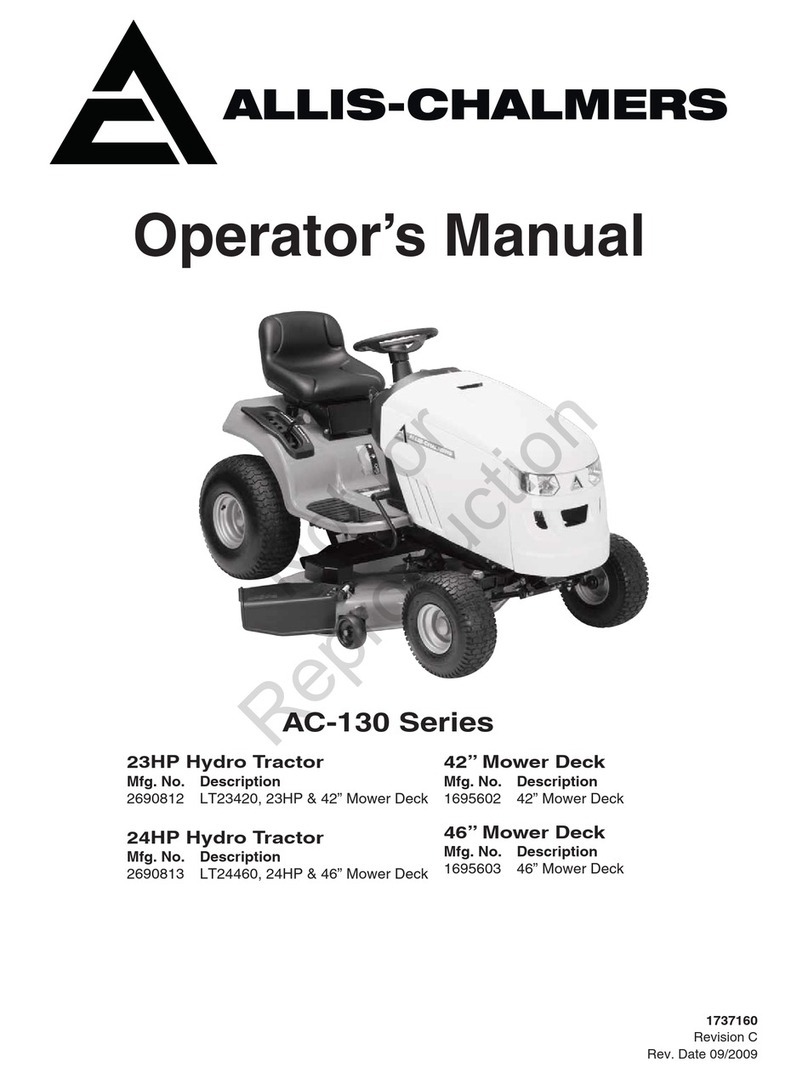
Allis-Chalmers
Allis-Chalmers ac130 series User manual
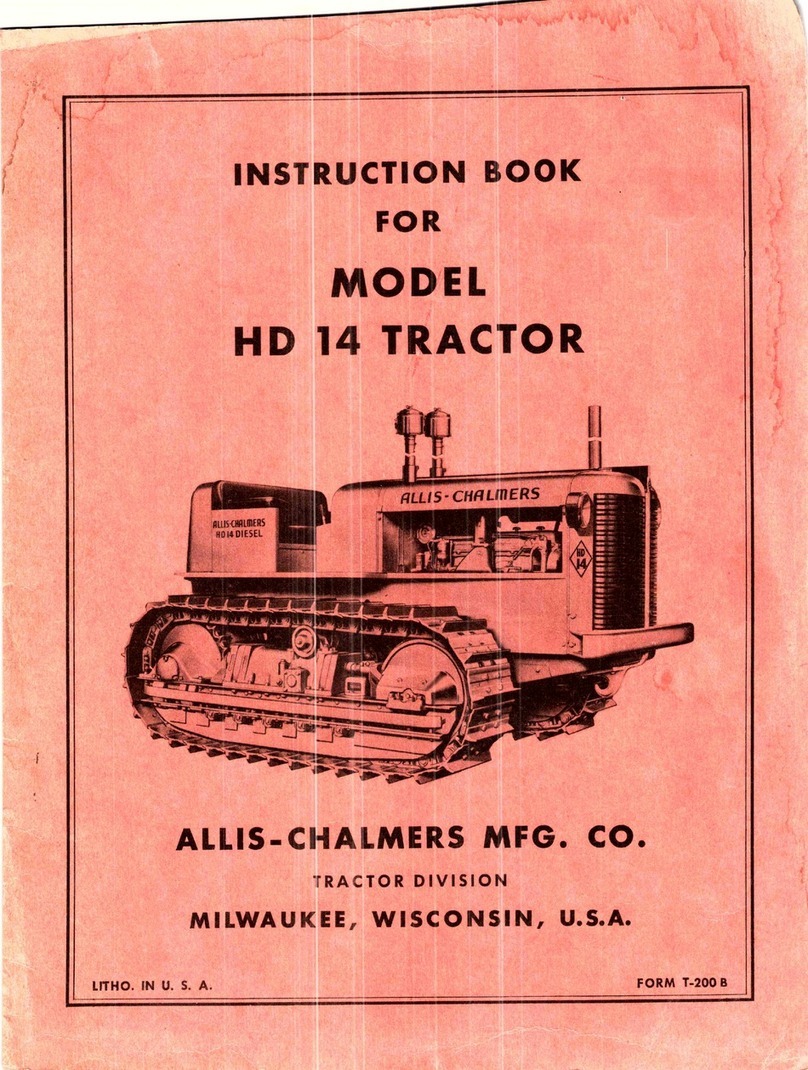
Allis-Chalmers
Allis-Chalmers HD-14 User manual

Allis-Chalmers
Allis-Chalmers HD-5 User manual
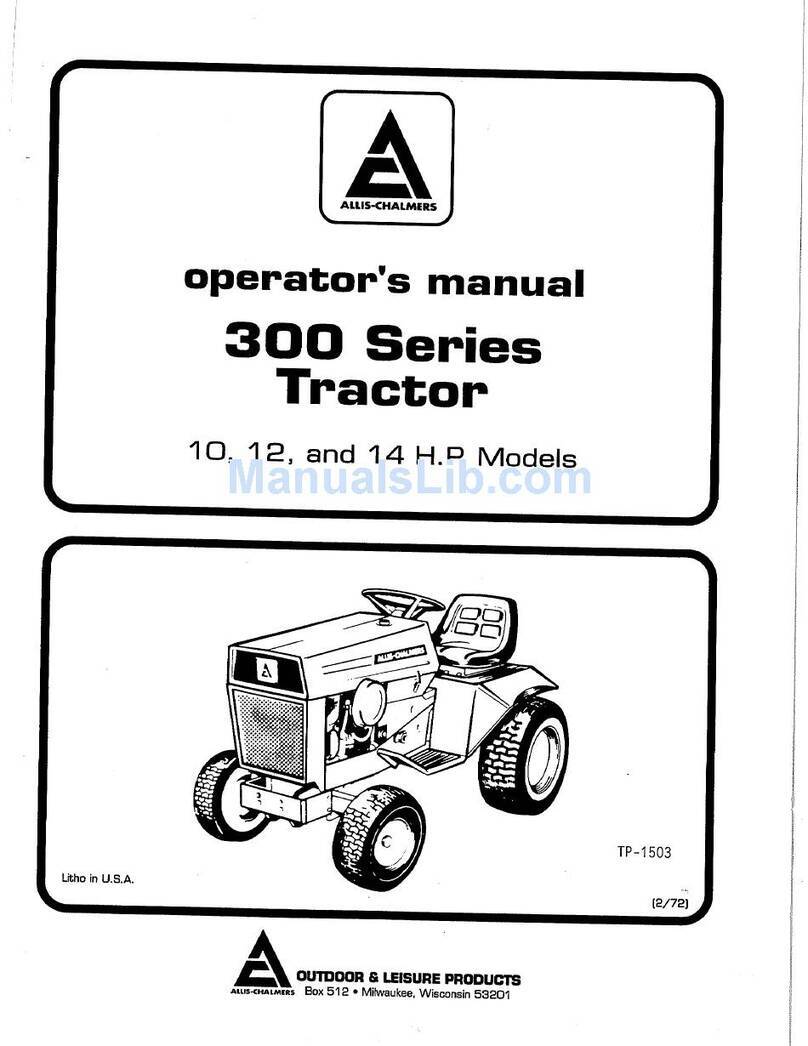
Allis-Chalmers
Allis-Chalmers 10 hp User manual
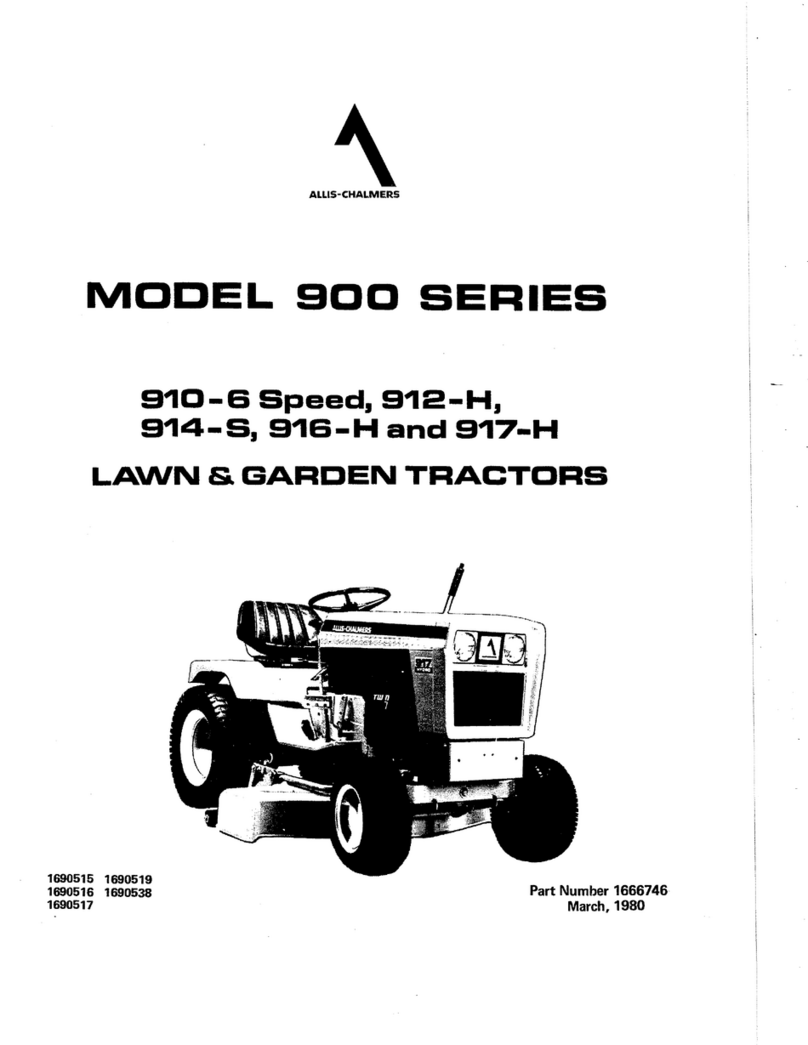
Allis-Chalmers
Allis-Chalmers 910-6 Speed User manual
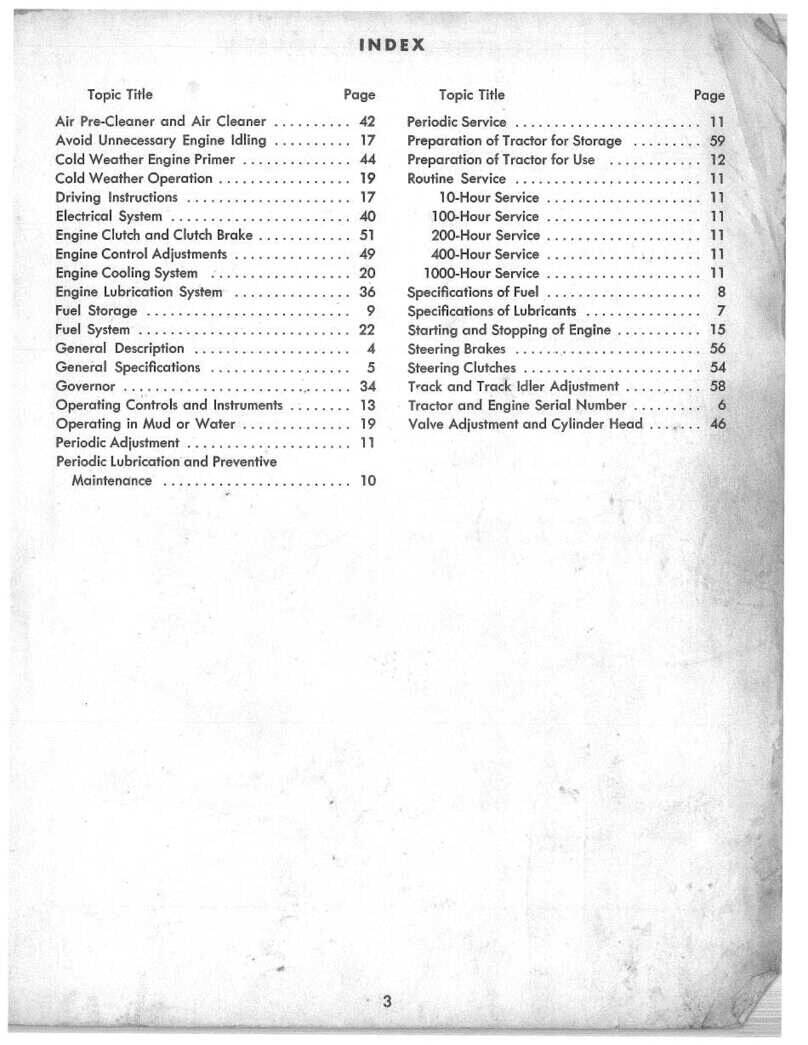
Allis-Chalmers
Allis-Chalmers HD 6B User manual
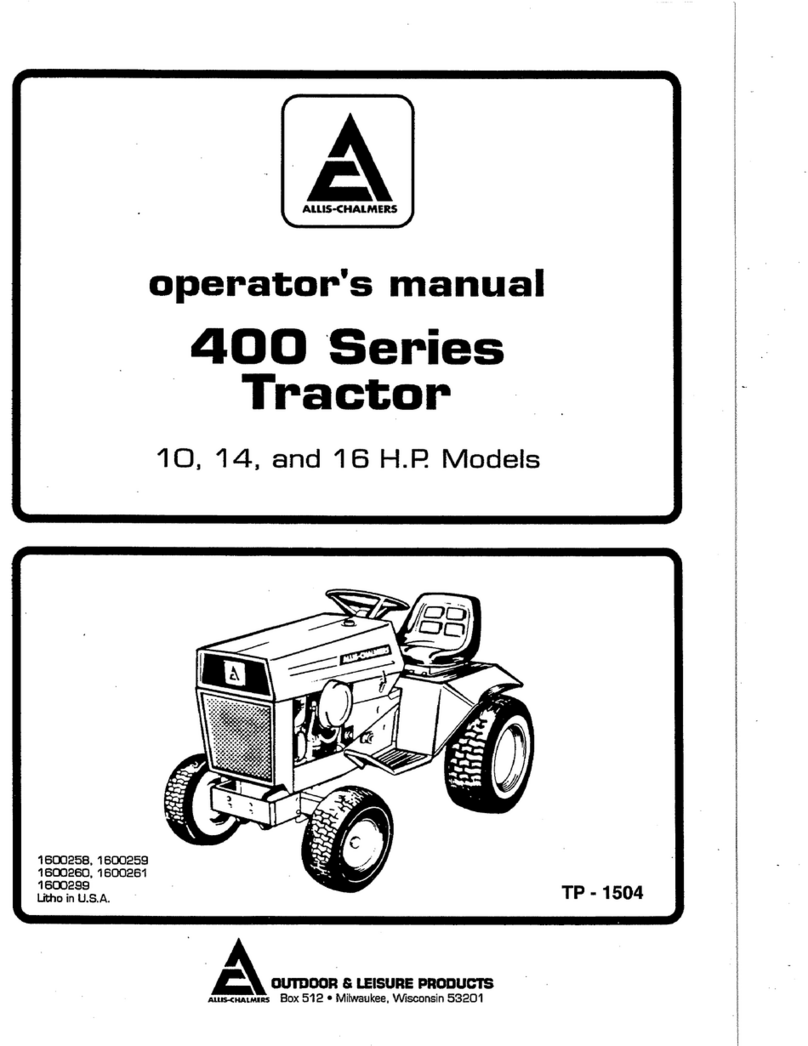
Allis-Chalmers
Allis-Chalmers regent hydro 14 User manual
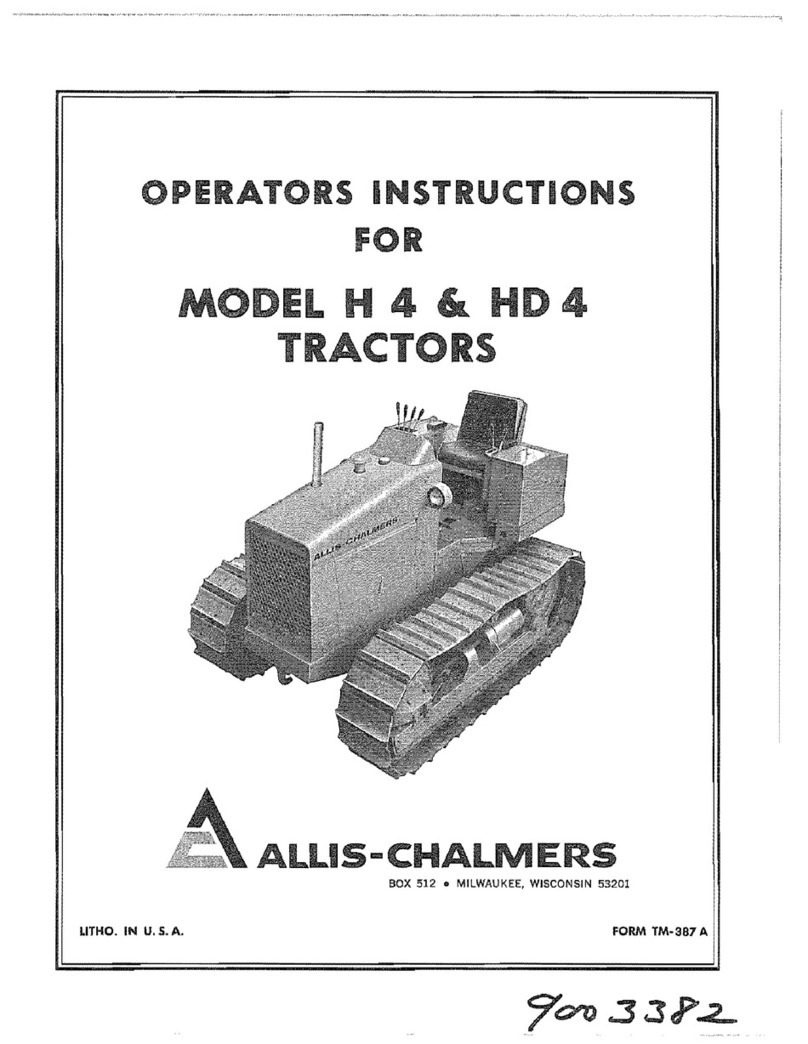
Allis-Chalmers
Allis-Chalmers H 4 Specifications
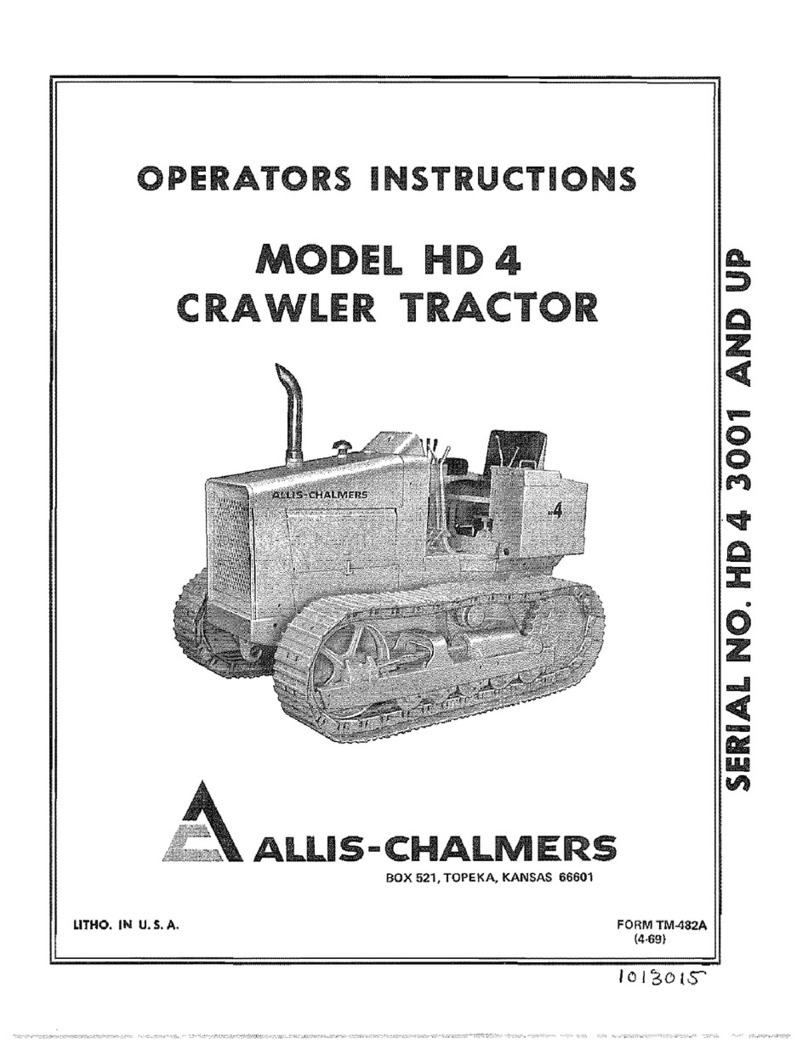
Allis-Chalmers
Allis-Chalmers HD-4 Specifications
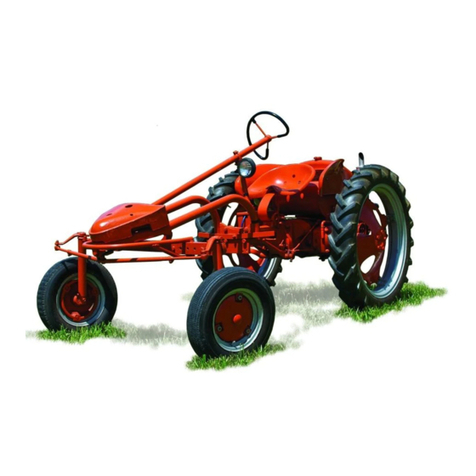
Allis-Chalmers
Allis-Chalmers G User manual
